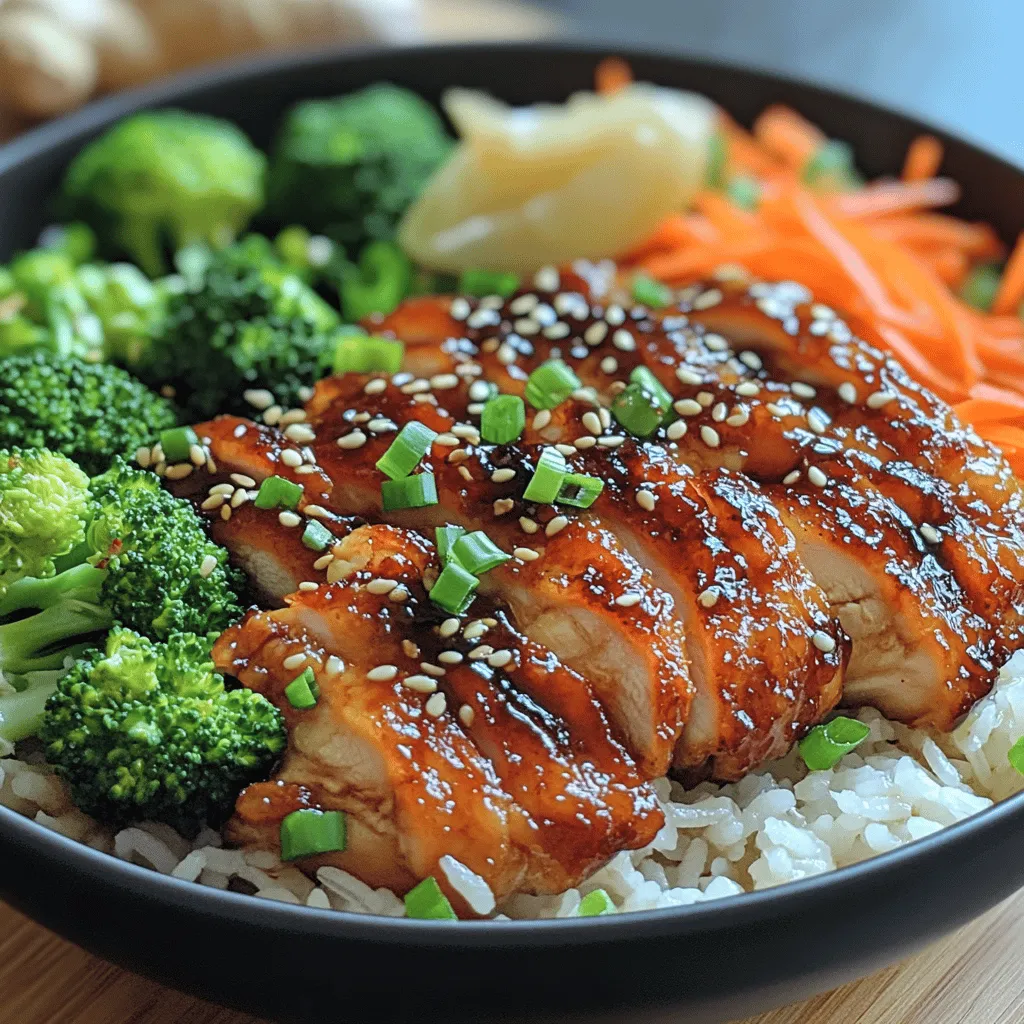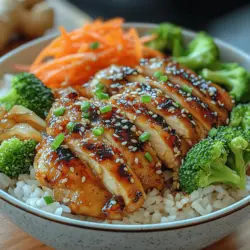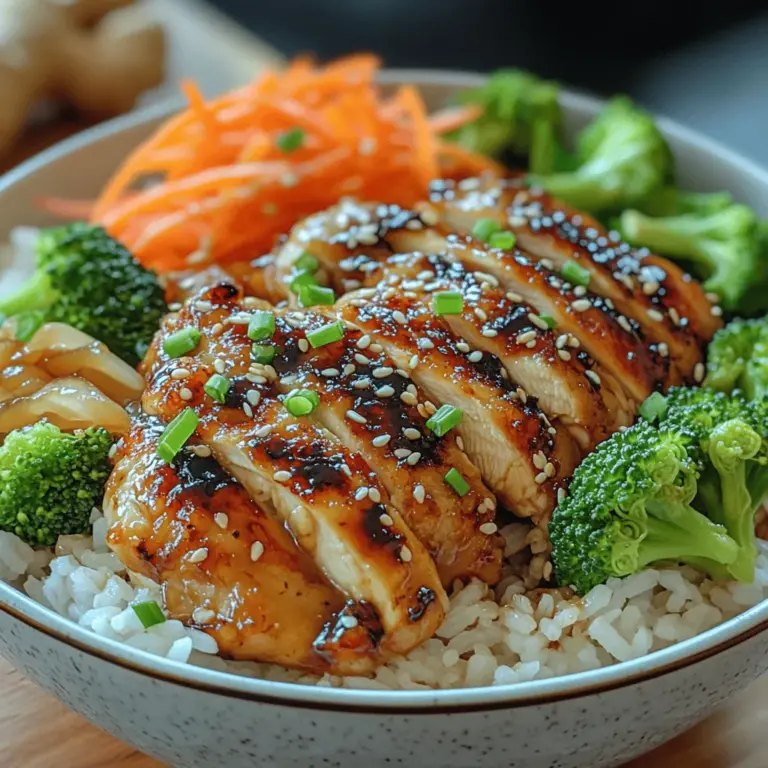Introduction
Teriyaki chicken rice bowls have become a beloved dish for many, gracing tables across the globe with their delightful mix of flavors and textures. This popular meal is not just about taste; it embodies the essence of comfort food while also being a healthy choice packed with protein and fresh vegetables. The allure of teriyaki chicken lies in its sweet and savory glaze, which elevates simple ingredients into a culinary masterpiece. Making this dish at home allows you to control the ingredients, ensuring a healthier option tailored to your taste preferences and dietary needs.
Beyond the delicious flavor profile, one of the greatest joys of preparing teriyaki chicken rice bowls at home is the satisfaction that comes with cooking. The aroma of marinated chicken sizzling in the pan, combined with the enticing scent of jasmine rice cooking, creates an inviting atmosphere in your kitchen. With just a handful of ingredients, you can create a meal that not only nourishes the body but also warms the heart.
In this article, we will take you through the journey of creating the perfect teriyaki chicken rice bowl, exploring the unique flavors that make this dish so special. From understanding the origins and components of teriyaki to breaking down the essential ingredients and providing step-by-step instructions, you’ll be well-equipped to impress family and friends with your culinary skills.
Understanding Teriyaki Chicken
The Teriyaki Technique and Flavor Profile
Teriyaki is more than just a popular sauce; it represents a cooking technique that originated in Japan. The term “teriyaki” is derived from two Japanese words: “teri,” which refers to the sheen or luster achieved by the sugar content in the sauce, and “yaki,” which means to grill or broil. Traditionally, this method involves marinating meat or fish in a mixture of soy sauce, sake, and mirin before grilling it to perfection. The result is a beautifully glazed dish that is both savory and slightly sweet, making it incredibly appealing to the palate.
The flavor profile of teriyaki chicken is characterized by a harmonious balance of salty, sweet, and umami notes. The rich soy sauce provides depth, while the addition of sugar or honey contributes that signature sweetness. When paired with the aromatic notes of garlic and ginger, each bite of teriyaki chicken becomes a delightful experience that transports you straight to the heart of Japanese cuisine.
Historical Background of Teriyaki in Japanese Cuisine
The roots of teriyaki can be traced back to the Edo period in Japan (1603-1868), where grilling meat became popular. However, it wasn’t until the mid-20th century that teriyaki as we know it today gained international popularity. Japanese immigrants introduced the technique and flavors to Western countries, particularly in the United States, where it quickly became a staple in Japanese restaurants and households alike.
As the dish evolved, so did the variations, leading to different interpretations of teriyaki chicken around the world. In some cultures, teriyaki is served with pineapple or other tropical fruits, while others may incorporate different marinades or cooking methods. This adaptability has made teriyaki chicken a beloved dish across various cuisines, allowing it to be enjoyed by many.
Variations of Teriyaki Chicken Across Different Cultures
While the traditional Japanese teriyaki chicken is a classic, numerous variations have emerged, reflecting local ingredients and preferences. For example, in Hawaiian cuisine, teriyaki chicken is often grilled and served with rice and fresh pineapple, adding a tropical twist. In Western adaptations, teriyaki flavors may be incorporated into stir-fries, sandwiches, or even salads, showcasing the versatility of this beloved dish.
Each variation brings its own flair while maintaining the core essence of teriyaki, making it accessible and enjoyable for diverse palates. Whether you prefer a traditional approach or a creative twist, teriyaki chicken rice bowls can cater to your taste and dietary needs.
Ingredients Breakdown
Creating a delicious teriyaki chicken rice bowl starts with the right ingredients. Let’s break down the key components that contribute to the dish’s delightful flavors and textures.
Chicken Marinade Components
The marinade is crucial for infusing the chicken with flavor and tenderness. Here are the essential ingredients:
– Soy Sauce: This salty, umami-rich ingredient serves as the foundation of the marinade. It not only enhances the chicken’s flavor but also helps to tenderize the meat.
– Brown Sugar: The sweetness of brown sugar balances the saltiness of the soy sauce, creating that characteristic teriyaki glaze. It caramelizes beautifully during cooking, giving the chicken a glossy finish.
– Rice Vinegar: A splash of rice vinegar adds acidity, which brightens the overall flavor profile and prevents the dish from becoming overly sweet. It also complements the other ingredients by adding depth.
– Sesame Oil: This fragrant oil contributes a nutty aroma and flavor that rounds out the marinade. A small amount goes a long way in elevating the dish.
– Garlic and Ginger: Fresh garlic and ginger are vital in providing aromatic notes that enhance the chicken’s flavor. They bring warmth and complexity to the marinade, making each bite more enjoyable.
Rice Preparation
The choice of rice is equally important in achieving a satisfying teriyaki chicken rice bowl.
– Jasmine Rice: Known for its delicate floral aroma and slightly sticky texture, jasmine rice pairs perfectly with teriyaki chicken. Its ability to absorb flavors makes it an ideal base for the dish.
– Rinsing and Cooking Methods: Properly rinsing jasmine rice removes excess starch, resulting in a less sticky texture and fluffier grains. Cooking it using the absorption method ensures that the rice is cooked evenly, allowing for a perfect balance with the chicken and sauce.
Toppings for Added Nutrition and Flavor
To elevate your teriyaki chicken rice bowl, consider adding a variety of colorful and nutritious toppings:
– Broccoli: This vibrant green vegetable is rich in vitamins and adds a satisfying crunch to the bowl. Lightly steaming or sautéing the broccoli before adding it to the dish ensures it retains its bright color and nutrients.
– Carrots: Shredded or sliced carrots introduce sweetness and a pop of color. They are not only visually appealing but also provide additional fiber and nutrients.
– Green Onions: Chopped green onions add a fresh, mild onion flavor that brightens the dish. They also contribute a lovely garnish that enhances the overall presentation.
– Sesame Seeds: Toasted sesame seeds add a delightful crunch and nuttiness, enhancing both the texture and flavor of your teriyaki chicken rice bowl.
– Pickled Ginger: Often served as a condiment with Japanese dishes, pickled ginger offers a tangy contrast to the sweet teriyaki chicken, cleansing the palate and adding an extra layer of flavor.
With these ingredients in mind, you’re ready to embark on the process of creating your own teriyaki chicken rice bowl. The balance of flavors, textures, and colors will not only satisfy your hunger but also make for a stunning presentation that is sure to impress anyone at your dining table.
Stay tuned as we delve into the step-by-step instructions for crafting this delectable dish, ensuring that every bite is as delicious as it is visually appealing.

Detailed Preparation for Marinating the Chicken
Marinating the chicken is a crucial step in crafting the perfect Teriyaki Chicken Rice Bowls. The marinade not only infuses the chicken with flavor but also helps to tenderize the meat. Start by cutting boneless, skinless chicken thighs or breasts into bite-sized pieces. This increases the surface area for the marinade to penetrate, resulting in more flavorful chicken.
To prepare the marinade, combine soy sauce, mirin, rice vinegar, minced garlic, and grated ginger in a bowl. You can also add a touch of sesame oil for an extra layer of depth. Whisk the ingredients together until they are well-blended. Place the chicken pieces into a resealable plastic bag or a shallow dish, and pour the marinade over them, ensuring each piece is coated evenly. Seal the bag or cover the dish and let it marinate.
Importance of Timing in Marination
Timing is essential in the marination process. For optimal flavor, allow the chicken to marinate for at least 30 minutes, but for the best results, aim for 2 hours. If time permits, marinating overnight in the refrigerator will yield even better flavor development. However, be cautious not to exceed the marination time beyond 24 hours, as the proteins in the chicken can break down too much, leading to a mushy texture.
Comprehensive Guide on Cooking the Jasmine Rice
While the chicken is marinating, you can prepare the jasmine rice. This fragrant rice variety complements the teriyaki flavors beautifully. Start by rinsing 1 cup of jasmine rice under cold water until the water runs clear; this removes excess starch and prevents the rice from becoming gummy.
In a medium saucepan, combine the rinsed rice with 1.5 cups of water and bring it to a boil over medium-high heat. Once boiling, reduce the heat to low, cover the saucepan, and simmer for about 15 minutes. Avoid lifting the lid during cooking, as this can disrupt the steam that helps the rice cook evenly. When the time is up, remove the saucepan from heat and let it sit, covered, for another 10 minutes. This resting period allows the rice to finish cooking and absorb any remaining moisture, resulting in perfectly fluffy rice.
Techniques to Ensure Perfect Rice Texture
To achieve the ideal texture for your jasmine rice, consider the following techniques:
1. Proper Rinsing: Always rinse your rice to remove excess starch.
2. Correct Water Ratio: The standard ratio of jasmine rice to water is typically 1:1.5, but you may want to adjust slightly based on your preferences or brand of rice.
3. Steaming: Let the rice rest after cooking with the lid on; this steaming process is critical for achieving a fluffy consistency.
Cooking the Chicken: Tips for Achieving the Ideal Sear and Flavor
Once the chicken has marinated for the desired time, it’s time to cook it. Heat a tablespoon of vegetable oil in a large skillet or wok over medium-high heat. Once the oil is shimmering, add the marinated chicken pieces in a single layer, ensuring not to overcrowd the pan. This allows for a better sear.
Cook the chicken for about 5-7 minutes, turning occasionally until the pieces are golden brown and cooked through. For optimal flavor, let the chicken sear undisturbed for the first 3 minutes before flipping. If you have excess marinade left, you can add it to the pan when the chicken is nearly done cooking, allowing it to thicken slightly and glaze the chicken.
Importance of Checking Internal Temperature for Safety
To ensure your chicken is safe to eat, use a meat thermometer to check the internal temperature. The USDA recommends that chicken be cooked to an internal temperature of 165°F (75°C). Once cooked, remove the chicken from the heat and allow it to rest for a few minutes before serving. This resting period allows the juices to redistribute throughout the meat, enhancing flavor and juiciness.
Preparing the Teriyaki Sauce: Achieving the Right Consistency
For the teriyaki sauce, you can either use store-bought or make it from scratch. To prepare a homemade version, combine soy sauce, mirin, brown sugar, and a bit of ginger in a small saucepan. Bring this mixture to a simmer over medium heat, stirring often until the sugar dissolves.
Optional Thickening Method Using Cornstarch
If you prefer a thicker teriyaki sauce, prepare a cornstarch slurry by mixing 1 tablespoon of cornstarch with 2 tablespoons of cold water. Slowly whisk this slurry into the simmering sauce and continue cooking for an additional 2-3 minutes until it reaches your desired thickness. Keep in mind that the sauce will thicken further as it cools.
Assembling the Rice Bowls: Presentation Tips for a Visually Appealing Dish
Now that all components are ready, it’s time to assemble your Teriyaki Chicken Rice Bowls. Start by spooning a generous portion of jasmine rice into each bowl as the base. Layer the cooked chicken on top, and then drizzle with the teriyaki sauce.
For a visually appealing presentation, consider adding colorful toppings such as sliced green onions, sesame seeds, and steamed broccoli or snap peas. The contrast of flavors and colors will enhance the overall dining experience.
Suggestions for Layering Ingredients for Optimal Flavor Distribution
When assembling your rice bowls, think about layering ingredients to maximize flavor. Start with the rice, then add the chicken, followed by the teriyaki sauce, and finish with fresh toppings. This method ensures that each bite is packed with flavor and texture, providing a balanced and satisfying dish.
Nutritional Information
Understanding the nutritional content of your Teriyaki Chicken Rice Bowls can help you appreciate their health benefits. Each serving typically contains:
– Calories: Approximately 450-500 calories
– Macronutrients:
– Carbohydrates: 60g
– Proteins: 30g
– Fats: 10g
These bowls are also rich in essential vitamins and minerals, including vitamin C from the vegetables, iron from the chicken, and B vitamins from the rice. Incorporating these bowls into a balanced diet can support overall health and wellness.
Customization Options
To cater to different dietary preferences, consider the following substitutions and additions:
1. Vegetarian Option: Substitute the chicken with tofu or tempeh, marinated and cooked in the same manner.
2. Gluten-Free Option: Use tamari instead of soy sauce to make the dish gluten-free.
3. Additional Toppings: Enhance your bowls with avocado slices, edamame, or pickled ginger for extra flavor and nutrition.
Conclusion
Teriyaki Chicken Rice Bowls offer a delightful combination of flavors, textures, and colors that can brighten any meal. The balance of savory chicken, fluffy jasmine rice, and vibrant vegetables creates a nourishing dish perfect for family dinners or meal prep. Preparing this recipe at home not only allows you to control the ingredients but also fosters the joy of cooking and sharing meals with loved ones.
Encourage your family and friends to gather around the table and enjoy the delicious rewards of your culinary efforts. Embrace the experience of making Teriyaki Chicken Rice Bowls, and savor every bite!

